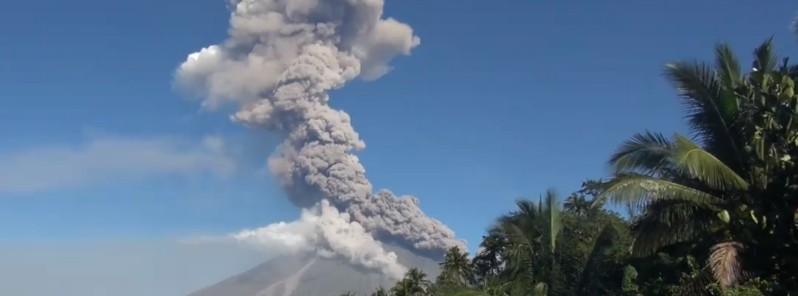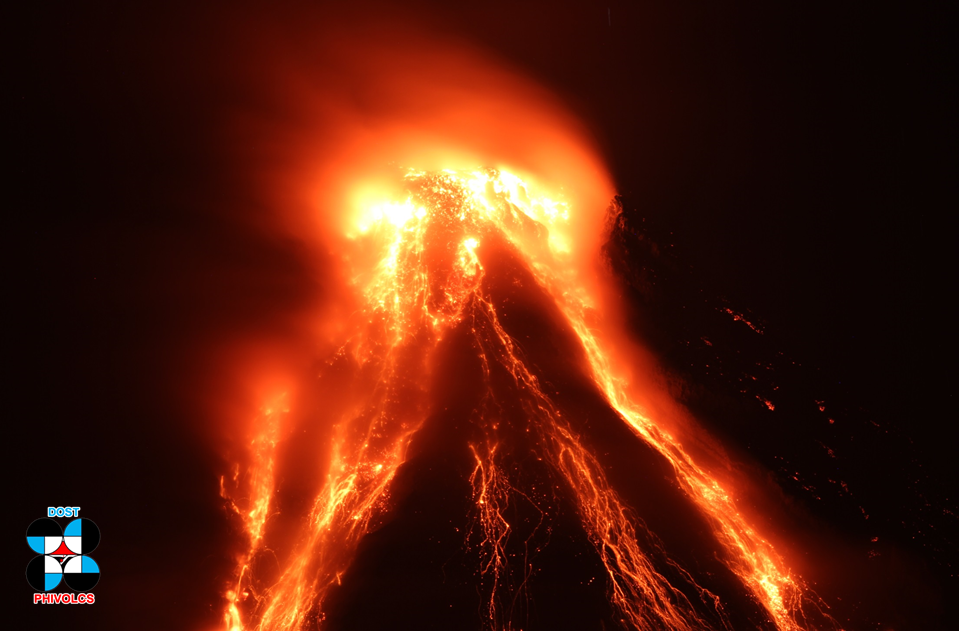At least 56 217 evacuated around Mayon volcano, Philippines

More than 56 000 people living around erupting Mayon volcano in the Philippines have left their homes since January 13, 2018. Following a powerful eruption on January 22, PHIVOLCS raised the Alert Level to 4 and extended the danger zone.
With the Alert Level now on 4 of 5, the Danger Zone is extended to 8 km (5 miles) from the summit vent, forcing thousands more to evacuate, including 12 000 who returned home last week. The total number rose to at least 56 217 on Tuesday, January 23 and the evacuation is still not over. Residents are taking shelter in 46 evacuation camps.
At 04:43 UTC on January 22 (12:43 local time), a dense 5-km (3.1 miles) high eruption column was generated by a short-lived phreatomagmatic eruption that lasted about 8 minutes based on seismic record. This is 7.6 km (25 000 feet) above sea level.
Cousin staying in Legazpi, Albay sent me this pic, #Mayon #MayonVolcano spewing ash this afternoon pic.twitter.com/EhsjaV7wiu
— Menard Osena (@Menardconnect) January 22, 2018
The event generated pyroclastic flows on gullies and barrancos heading the Miisi, Bonga, Buyuan, Basud, San Andreas, Buang, Anoling and other minor rivers within 4 km (2.5 miles) of the summit vent. This is well within the Permanent Danger Zone (PDZ).
Volcanic ash was blown west and fell on the Municipalities of Guinobatan, Camalig, Oas, Polangui and Iriga City, PHIVOLCS said.
Albay Governor said zero visibility has been reported in parts of Guinobatan, Ligao, and Camalig after the major ash eruption, advising everyone to wear their face masks and to stay indoors, especially those in the 3rd district of Albay. Classes in all public and private schools across the entire province have been suspended.
BREAKING: Mayon Volcano spews ashfall as far as ten kilometers, zero visibility up in the 2nd and 3rd districts of Albay. | via Connie Destura pic.twitter.com/UFPjeuEk6V
— Phil News Agency (@pnagovph) January 22, 2018
This was followed by a minor degassing event at 10:51 UTC that generated a short, 500 meter-high (1 640 feet) ash plume.
Between 13:37 PM and 21:25 UTC, five episodes of intense but sporadic lava fountaining from the summit crater lasting 3 to 30 minutes occurred. The lava fountains reached 500 – 700 meters (up to 2 296 feet) high and generated ash plumes that reached 2.5 – 3 km (1.5 – 1.8 miles) above the crater. The events fed lava flows on the Miisi and Bonga Gullies, sprayed near-vent lava spatter and fed incandescent rockfall on the summit area.
Similar activity continued on January 23. Lava fountaining reached a height of 600 m (1 968 feet) and generated a 3-km (9 842 feet) high ash plume:
PHIVOLCS is urging the public to be vigilant and desist from entering the 8 kilometer-radius danger zone, and to be additionally vigilant against pyroclastic density currents, lahars and sediment-laden streamflows along channels draining the edifice.


Lava fountaining on Mayon volcano – January 21, 2018. Credit: PHIVOLCS
Geological summary
Beautifully symmetrical Mayon volcano, which rises to 2 462 m (8 077 feet) above the Albay Gulf, is the Philippines' most active volcano. The structurally simple volcano has steep upper slopes averaging 35-40 degrees that are capped by a small summit crater. Historical eruptions at this basaltic-andesitic volcano date back to 1616 and range from strombolian to basaltic plinian, with cyclical activity beginning with basaltic eruptions, followed by longer term andesitic lava flows.
Eruptions occur predominately from the central conduit and have also produced lava flows that travel far down the flanks. Pyroclastic flows and mudflows have commonly swept down many of the approximately 40 ravines that radiate from the summit and have often devastated populated lowland areas.
Mayon's most violent eruption, in 1814, killed more than 1 200 people and devastated several towns. (GVP)
Featured image: Mayon volcano, Philippines on January 23, 2018. Credit: PHIVOLCS

Commenting rules and guidelines
We value the thoughts and opinions of our readers and welcome healthy discussions on our website. In order to maintain a respectful and positive community, we ask that all commenters follow these rules:
We reserve the right to remove any comments that violate these rules. By commenting on our website, you agree to abide by these guidelines. Thank you for helping to create a positive and welcoming environment for all.